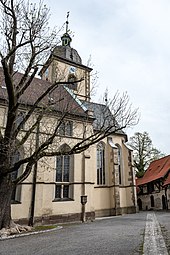St. Michael (Gochsheim)
The St. Michaelskirche in Gochsheim is part of the Gochsheimer Kirchenburg , one of the oldest preserved fortified churches in Franconia . The church was built in 1511, is named after the Archangel Michael and belongs to the Evangelical Lutheran parish in Gochsheim.
prehistory
A church stood on the site of today's church well before the year 1000. Remains of it can still be seen in the Kirchgaden north of today's church. Small windows in the wall probably belonged to the older church. In addition, two goblets from around 1400 have been preserved to this day. The cemetery surrounding the church lasted until 1785.
Kirchgaden
history
The church is completely surrounded by defensive walls, with an access gate on the village square (Am Plan). Along the inside of the wall there are gaden , which served as storage for times of emergency and during sieges of the fortified church. The Gaden date from the 13th and 14th centuries .
Over the centuries the Gaden lost its importance and were left to decay. The community of Gochsheim finally acquired the Kirchgaden and carried out an extensive restoration.
Reichsdorf Museum
Today the Reichsdorf Museum is housed in Kirchgaden. The collections present Gochsheim's rich history, a center of Franconian tradition. A secondary section shows the history of cycling and cycling , which is closely linked to nearby Schweinfurt , and the professions of büttner (barrel maker) and setter .
- Kirchgaden
St. Michael
On the south wall of the choir and in a corner of the tower, the year 1511 is carved in stone: This is the year the choir and tower as well as the painting of the ceiling of the choir come from.
The church in Gochsheim has been Protestant since the Reformation in 1540 or 1543. The octagonal font, which was removed during the renovation in 1872, dates from 1545. After being rediscovered in a nearby garden, it was restored and put back in the church for the 1986 harvest festival. The church now has a modern baptismal font in the nave and the historic baptismal font in the choir.
The old nave was demolished and enlarged in 1872. The inauguration of the enlarged church took place on November 9, 1872; Altar, pulpit and baptismal font were designed in the neo-Gothic style.
In the years 1966–1968 a thorough renovation took place in which the interior was completely rebuilt. The two galleries were reduced to one, the old high altar removed and replaced by a table altar . The old stair tower on the church tower on the south side was demolished. The neo-Gothic style of the interior gave way to a deliberately bright and modern design. The four evangelist figures in the pulpit from 1872 are now hanging on the wall of the choir, together with the old altar crucifix.
Bells
The four bells in the church date from 1559 to 1774.
Works of art
Stained glass window in the choir room
The glass windows in the choir were installed in 1994 by the Schweinfurt glass artist Günther Johrend. They depict the following scenes, with an angel on each scene:
- Annunciation
- Preaching the Christmas message to the shepherds in Bethlehem
- Jesus in the garden of Gethsemane
- The angel at the grave announces the resurrection of Jesus
- The Archangel Michael
- Last judgment trumpet angel
Figure of the risen Christ
The figure was carved by Ulsamer in Schweinfurt in 1983. It hangs in the place where the pulpit was until 1968.
Wayside shrine in the churchyard
A wayside shrine in the churchyard from 1987 reminds us that there was a cemetery here until 1785. Bernhardt von Clairvaux, Archangel Michael and the risen Christ can be seen on it.
- St. Michael from the inside
Web links
Individual evidence
- ↑ a b c Schweinfurt 360 °: Reichsdorf Museum in Kirchgaden Gochsheim. Retrieved November 2, 2018 .
Coordinates: 50 ° 1 ′ 10.9 ″ N , 10 ° 16 ′ 56.2 ″ E









